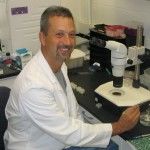Overview: C. elegans express a rhythmic behavior whose timing is controlled by oscillatory Ca2+ signaling. The behavior is anatomically simple, with the intestine, several muscle cells, and two neurons communicating to establish the defecation motor program (DMP). The posterior cells of the intestine are the behavioral pacemaker, and the canonical signaling cascades that regulate basal, rhythmic Ca2+ oscillations in these cells have been well-characterized. However, ion transport during defecation is essential for nutrient uptake and helps to set metabolic homeostasis. Here, we hypothesize that mitochondrial function and oscillatory Ca2+ signaling are integrated through novel, recently identified signaling pathways, and we propose to identify the underlying mechanisms that are operative in the pacemaker cells of the intestine. Our results are likely to be broadly significant, as the molecular processes we will focus on, mitochondrial Ca2+ uptake, the mitochondrial unfolded protein response (UPRmt) and mitochondrial reactive oxygen species (ROS) generation, are well conserved among phyla.
Intellectual Merit: This application represents a logical extension of our previous work focusing on the defecation model in C. elegans, and the approaches we propose rely on combining two fields in which our laboratory has significant experience: electrolyte transport and mitochondrial biology. The main function of mitochondria is to transduce energy through oxidative phosphorylation, a process which generates most of the endogenous ROS in cells. However, mitochondria are also well-recognized to contribute to Ca2+ signaling by buffering Ca2+. Recent groundbreaking work has uncovered novel molecular mechanisms that contribute to Ca2+ uptake by mitochondria, to maintaining organelle-specific protein homeostasis, and to signaling through ROS. Each of the aims in this proposal is intended to query these specific aspects of mitochondria’s function with respect to their effect on oscillatory Ca2+ signaling. The use of C. elegans poses significant advantages for this project, with a unique repertoire of genetic reagents available, as well as a set of biochemical and physiologic tools for mitochondrial research that we have developed to complement our established model of rhythmic ion transport. This proposal represents an outstanding opportunity to develop a more sophisticated understanding of how mitochondria, oscillatory Ca2+ signaling and rhythmic behavior are coupled.
Broader Impact: Our laboratory has a strong history of contributing to the professional development of trainees from under-represented backgrounds, and we will continue to recruit heavily in this area. We are fully vested in community outreach and to promoting the scientific literacy of society. As such, we propose to initiate a K-12 learning program, spearheaded by a former postdoctoral trainee from the lab who comes from an under-represented background and has extensive experience in this area. We will also expand our existing website to facilitate communication with the stakeholder community, and we will use the website to disseminate teaching modules developed through our learning program. We have recruited an advisory committee who will use established metrics to evaluate our progress toward these goals. Finally, the molecular genetic tools that we will develop as a result of this research will enable new possibilities for manipulating cell signaling.
